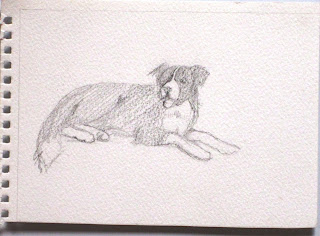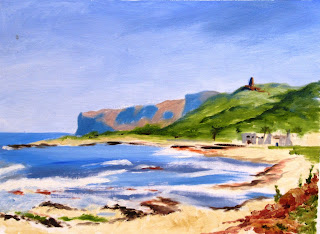e.g in this drawing of my cat hiding in a shoe box, I have drawn the shape between the tail and the body, and the triangle between the lid and the box, to get the cat and the box correct.
In this drawing of cheeseplant leaves, I have drawn the shapes of the holes - ie. the spaces in and around the leaf - to get the leaf right.
If you carefully draw the areas around and between parts of your object, rather than the object itself, this will help you to draw those shapes much better. It stops your brain wrongly editing shapes back to the symbol we have learned.
So to get this gymnast and her ribbon right, concentrate on the spaces between her limbs and body, and between her and the ribbon. ie. draw the shape of the sky seen between and around the main features.
For example - if you are drawing a jug or basket with a handle, drawing the space between the handle and the jug will help you to draw the jug /basket and the handle correctly.
If you are drawing a still life, or any group of objects, people or animals, get the shapes of the spaces between them right and you will get the objects themselves right.
Look at the shapes against the white table, and against the dark background - get these right to get the objects right, and in the right place. They are often little triangles , often curved triangles.
Here you can see the dark background - draw this correctly and the objects will be the right shape and correctly placed against each other.
In each of the following still lifes, look at the shapes around and between the objects - often little V shapes or triangles.
If you are drawing a chair, try drawing the space seen between the legs and bars - this will help you to get the chair right.
If you are drawing a person seated, draw the shapes of the spaces made between the limbs and the body and your drawing will be better, and easier to do. I have highlighted these negative spaces in black here:
If you are drawing this horse galloping towards you, with all those limbs foreshortened, focus instead on the shapes in green, the grass seen between the limbs.
Another trick is to get his silhouette right before you draw the details. This will help you cope with that foreshortened body and neck.
Draw the shapes between his legs and body correctly:
Draw the shapes seen behind the rider and horse - almost as if you are drawing the sky seen
behind them, between the bodies and limbs of horse and rider.
Here, I have carefully observed the shapes seen behind the horse and foal - ie. the shapes of patches of pale blue sky and pale gold foreground.
So Negative space is your invisible ally in drawing well!

























































